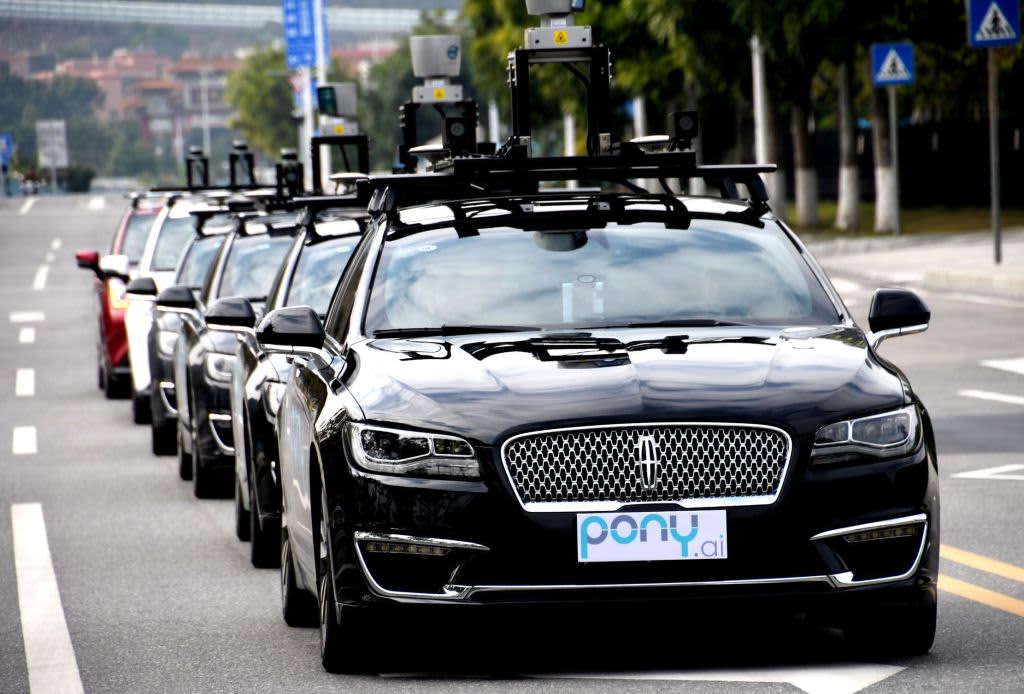Moving around China has changed since Covid — and the changes may be permanent

The coronavirus pandemic could provide boost to newer modes of transportation in China, such as making autonomous driving more mainstream, a panel of industry leaders told CNBC.
The Covid-19 outbreak accelerated the commercialization of autonomous aerial vehicles — or driverless drones — which were used to transport goods, medical supplies and even passengers to and from quarantine zones, Edward Xu, chief strategy officer at Chinese drone manufacturer EHang, told Arjun Kharpal during the virtual CNBC Evolve Global Summit on Wednesday.
The Guangzhou-headquartered company made headlines in 2016 when it revealed a passenger drone concept.
Pony.ai self-driving cars run along a road during a trial run on February 1, 2018 in Guangzhou, China.
VCG | Visual China Group | Getty Images
“Going forward, we are working with … Chinese government officials to accelerate the commercialization of our product,” Xu said, adding that the company has had two meetings with regulators and aims to have its passenger drones certified within two years.
Chinese driverless car start-up Pony.ai has sent some of its unmanned cars to ferry medical workers to Covid-affected areas and transport much needed goods. It showed people how new technology can be used to fight a pandemic, according to founder and CEO James Peng.
“What we can imagine that after the post-pandemic era, people will get more familiar, more comfortable with fully driverless vehicles and we are ready to push that,” he added.
Rising demand in urban mobility
While the pandemic made many commuters wary of public transportation, some turned to personal mobility devices for their travels.
Chinese electric scooter maker Niu Technologies saw a “huge demand in individual urban mobility devices,” according to CEO Yan Li. He said the company shipped almost 150,000 units of e-scooters in the first quarter.
Even after the pandemic, the trend is likely to stay, according to Li. He said people in China are likely to continue commuting on scooters as they offer more freedom compared with public transport.
“We don’t see the trend of people going back to public transportation. Lots of people are starting to get used to those individual mobility devices and I think that’s a good trend for us,” Li added.
Challenges ahead
Mainstream adoption of autonomous vehicles faces a number of challenges, according to the industry leaders. Pony.ai chief Peng listed three issues: technical advancement, regulation and consumer acceptance.
It takes time for customers to get used to how it feels and understand that autonomous driving is actually safer and more convenient way of transportation.
James Peng
Pony.ai
“I think from the technical point of view, we have made progress in leaps and bounds in the last several years,” he said. Peng added that the company obtained a fully driverless testing permit in California and is about to receive some in China as well.
Driverless vehicles have made plenty of progress over the years as companies repeatedly tested their technology to address potential problems and prevent accidents. Still, questions around safety from the public and regulators remain a major hurdle in the way of mainstream adoption.
Regulation is the “biggest bottleneck” when it comes to unmanned passenger drones, according to EHang’s Xu.
An Ehang 216, a two-seater autonomous aerial vehicle of drone maker EHang, is seen during its presentation in Vienna, Austria April 4, 2019.
Leonhard Foeger | Reuters
“Because so far there is no regulation. There is no precedence in the past which allow the AAV to fly over the urban area,” he said.
“Right now, the situation is becoming more convincing because we did handle the trial flights over about 43 cities in 8 countries with more than 4,000 flights done,” Xu added.
Convincing passengers to take either driverless cars or autonomous passenger drones also remains a major obstacle.
“That front, it takes time for customers to get used to how it feels (and understand that) autonomous driving is actually safer and more convenient way of transportation,” Peng said.




